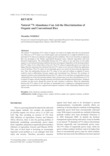The natural 15N abundance (δ15N value) of organic rice tends to be higher than that of conventional rice. However, as δ15N values vary in both organic and conventional rice, it might be difficult to use a particular δ15N value as an indicator of organic growth conditions. This review describes an approach that was developed at the Tohoku Agricultural Research Center, National Agriculture and Food Research Organization. The relationship between the δ15N values of rice and those of soil under organic or conventional farming conditions has been investigated. Regardless of the farming method, the δ15N values of rice reflect those of the soil. The δ15N values of organically grown rice tend to be higher than the regression line obtained from the δ15N values of rice and soil without the application of an N fertilizer. The δ15N values of conventionally grown rice tend to be lower than the regression line. Thus, the relationship between the δ15N values of rice and soil without an applied N source could be used to differentiate between organic and conventional rice. However, the existence of regional variation in the relationship between the δ15N values of rice and those of unamended soil can confound the use of this discriminant method. Such variation may occur due to the differences in δ15N of natural N inputs, and also through ammonia nitrification and subsequent denitrification. Temporal variation can also occur, though the reason for such variation is unknown. When the relationship between the δ15N values of rice and those of unamended soil is employed to distinguish between organic and conventional rice, regional and temporal variations in that relationship should be taken into account.

